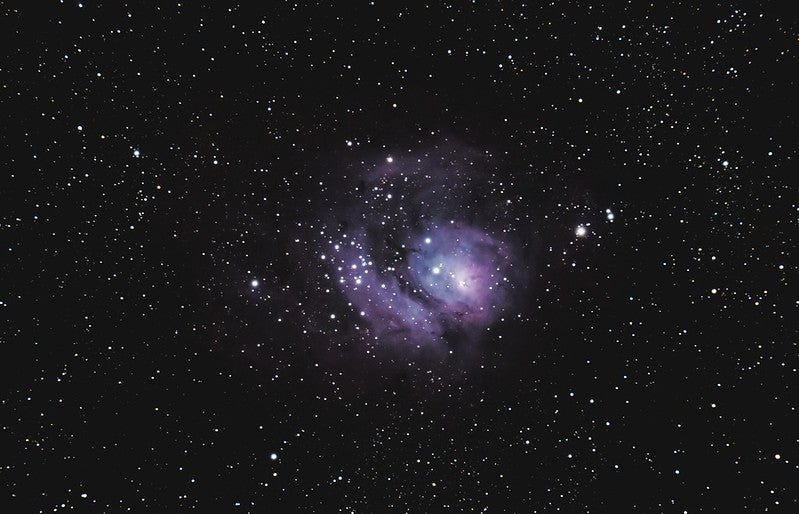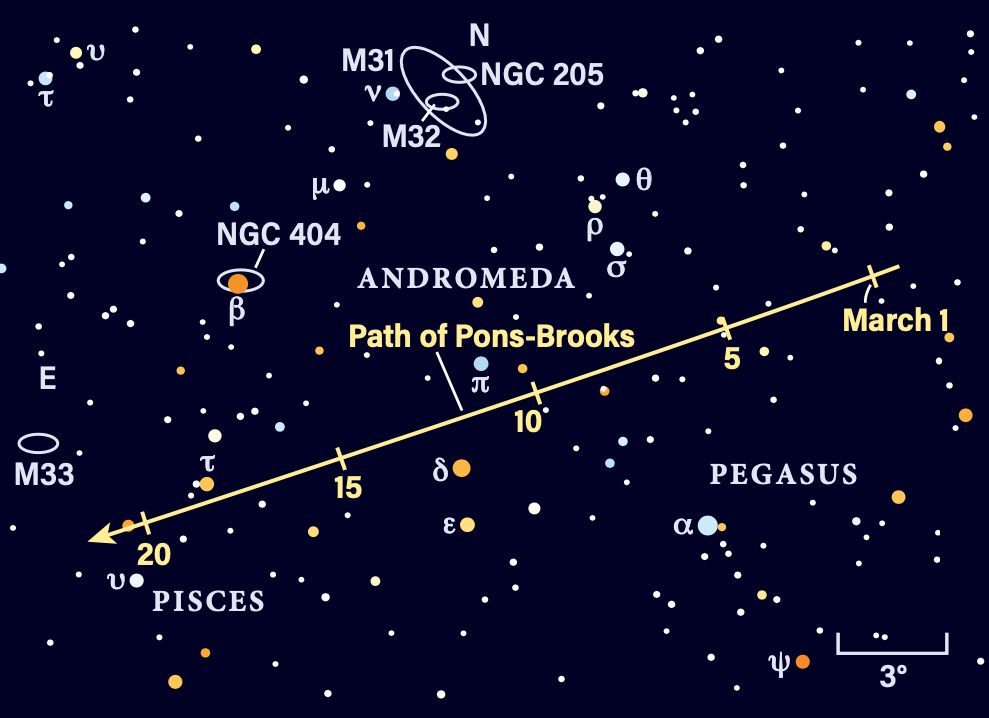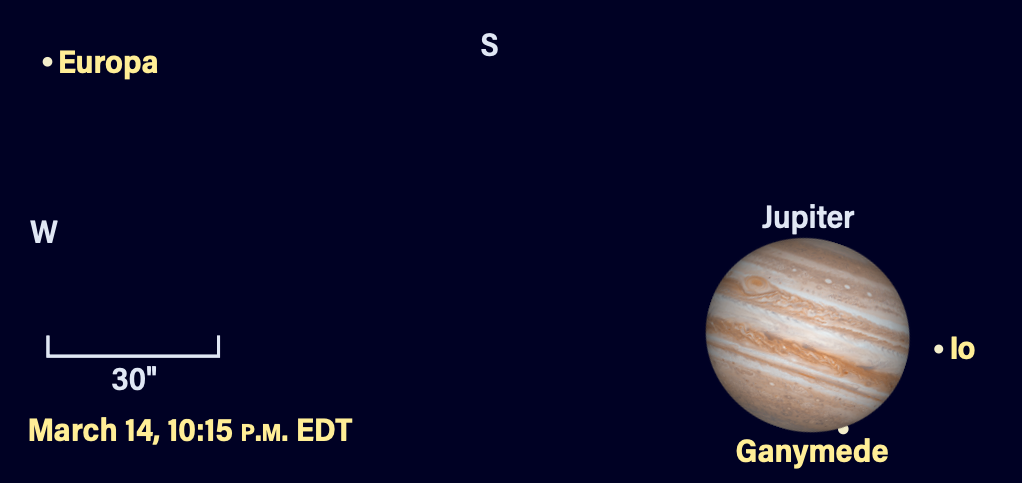
Friday, March 8
Jupiter’s moon Europa, which recently made headlines after NASA’s Juno spacecraft measured the amount of oxygen it produces, performs a disappearing act this evening as it slips behind and is occulted by the gas giant. Shortly before this happens, its fellow moon, Io, reappears from within the planet’s shadow.
At sunset, Jupiter is high in the west, shining at magnitude –2.1 as the brightest object in Aries the Ram. For those in the eastern half of the U.S., Jupiter starts the night with three visible moons: Europa alone to the west and Ganymede (closer) and Callisto to the east.
But keep watching — just after 8 P.M. EST, Io pops into view to Jupiter’s northeast, as it passes out of the planet’s shadow and into the sunlight. Meanwhile, Europa is closing in from the west, even as the planet sets for those on the East Coast. Around 9:30 P.M. CST, the icy moon disappears behind the planet’s limb; by tomorrow night, it will stand far east of the planet, with Io now alone to the west.
Sunrise: 6:21 A.M.
Sunset: 6:00 P.M.
Moonrise: 5:40 A.M.
Moonset: 4:03 P.M.
Moon Phase: Waning crescent (4%)
*Times for sunrise, sunset, moonrise, and moonset are given in local time from 40° N 90° W. The Moon’s illumination is given at 12 P.M. local time from the same location.
Saturday, March 9
You might be able to catch your first view of Mercury for the month this evening, as the planet shines at magnitude –1.5 and follows the sinking Sun down in the west. Some 30 minutes after sunset, the solar system’s smallest planet is just 3° high, possible to catch with binoculars or a telescope if you’ve got a clear western horizon.
But don’t spend too much time trying to catch it, because tonight marks 2024’s first — and best — chance to run the famous Messier marathon, during which observers try to net all 109 (or 110, depending on how you’re counting) of Messier’s objects in a single night. According to Lowell Observatory’s Tom Polakis, observers between 9° and 24° north latitude should be able to observe all 110 targets overnight tonight. There’s a second chance coming in April, though not all 110 objects will be visible then.
If you’re up for the challenge, Astronomy contributing editor Michael E. Bakich recommends at least a 3-inch telescope and a dark site, though more experienced observers with excellent skies can test their mettle with binoculars. Start with the spiral galaxy M74 in Pisces, which is about 40° high in the west at sunset from the U.S. Midwest. The galaxy glows at magnitude 9.4 and sits just over 1° northeast of Eta (η) Piscium. Focus on this spot and see how soon after sunset you can bag this galaxy, then move on to M77 in Cetus and keep going, following this handy list of Messier marathon targets by Bakich.
Sunrise: 6:20 A.M.
Sunset: 6:01 P.M.
Moonrise: 6:11 A.M.
Moonset: 5:23 P.M.
Moon Phase: Waning crescent (1%)
Sunday, March 10
If you’re up overnight running your Messier marathon, take note: Daylight saving time begins this morning. In regions that observe the time change, clocks will “spring forward” at 2 A.M. local time, skipping right to 3 A.M.
The Moon reaches perigee, the closest point to Earth in its orbit, shortly after, at 3:04 A.M. EDT. At that time, Luna will sit 221,764 miles (356,895 kilometers) away. And New Moon occurs at 5:00 A.M. EDT. Note that not all time zones may be observing daylight time at this point.
The best way to round out your Messier marathon is with M30, a globular cluster in Capricornus. This object will be low in the southeast, a mere 3° high just 10 minutes before sunrise (depending on your location). The cluster currently sits about 7.6° south (to the lower right) of Mars, which glows at magnitude 1.2 this morning. M30 itself is magnitude 7.2 and will be challenging — but hopefully not impossible — to pick out in the brightening twilight. Do make sure to put away your optics at least several minutes before the Sun rises from your location, which may differ slightly from the time below.
Sunrise: 7:19 A.M.
Sunset: 7:02 P.M.
Moonrise: 7:38 A.M.
Moonset: 7:39 P.M.
Moon Phase: New
Monday, March 11
With the Moon now New, take the chance to try spotting the zodiacal light after sunset before our waxing satellite begins to brighten the evening sky in the coming days.
The zodiacal light is a soft glow that comes from sunlight scattering off dust particles in the inner solar system, left by the passage of comets. This glow follows the plane of the ecliptic, along which you’ll also find the planets in our sky. Look west after the sky grows dark following sunset. The brightest point of light in that region of sky will be Jupiter, currently sitting below the V-shaped face of Taurus the Bull and the nearby Pleiades star cluster. If visible from your location, the zodiacal light will stretch upward from the horizon toward Jupiter, then on possibly even as far as the Pleiades.
Even if you can’t see this phenomenon, take some time to enjoy Taurus and all it has to offer, from the Pleiades and Hyades to the famous Crab Nebula, the remnant left behind by a massive star’s explosion at the end of its life and first on Messier’s list as M1.
Sunrise: 7:17 A.M.
Sunset: 7:03 P.M.
Moonrise: 8:04 A.M.
Moonset: 8:59 P.M.
Moon Phase: Waxing crescent (3%)

Tuesday, March 12
Comet 12P/Pons-Brooks is carving a path through Andromeda the Princess, passing due south of the famous Andromeda Galaxy (M31) tonight.
Observers seeking this pairing will need to be quick, stepping outside shortly after sunset to catch the region before it sinks too low in the northwest a few hours after the Sun disappears. Pons-Brooks lies 9° south of M31, so you’ll need a wide-field view to capture both at once.
Let’s start at the mighty galaxy, which glows at magnitude 3.4 and is visible to the naked eye under good conditions. Andromeda stretches nearly 180′ across at its longest, with its shorter axis a little less than half that. Through an eyepiece, it will likely look like a softly glowing white fuzzball, perhaps a bit brighter toward the central core. It lies just 1.3° west of magnitude 4.5 Nu (ν) Andromedae.
Drop due south to find the comet, which has been recently recorded around 6th magnitude — easy to pick up with binoculars or any small scope. Its green glow is readily visible in images as the comet heads for perihelion, the closest point to the Sun in its orbit, next month.
Sunrise: 7:16 A.M.
Sunset: 7:04 P.M.
Moonrise: 8:30 A.M.
Moonset: 10:16 P.M.
Moon Phase: Waxing crescent (8%)
Wednesday, March 13
The Moon passes 4° north of Jupiter at 9 P.M. EDT, offering a stunning post-sunset scene as the sky starts to grow dark. The delicate crescent Moon at that time is just 19 percent lit, hanging to the upper right of the bright “evening star” of Jupiter.
Use binoculars or a telescope to sweep a bit more than 6° above Jupiter to find the distant ice giant Uranus. Glowing at magnitude 5.8, the planet stretches just over 3″ across and will appear as a “flat,” gray-blue disk among the background stars. The Moon will continue along the ecliptic overnight, passing due north of Uranus early tomorrow morning.
With the Moon only partly illuminated, it’s a great opportunity to look for earthshine. This phenomenon occurs when sunlight bounces off Earth to light up the portions of the Moon’s nearside still in shadow. It is visible with the naked eye, though observing the Moon with binoculars or a telescope will bring out the subtle details of the dimly lit surface even more.
Meanwhile, let’s explore the few bright stars in Aries the Ram. The constellation’s alpha star is magnitude 2 Hamal, which sits about 12° to the lower right of Jupiter tonight. Its beta star is magnitude 2.6 Sheratan, located 4° southwest (to the lower left) of Hamal. Although not visible by eye, Sheratan is a binary system with a companion confirmed via spectroscopy, which can detect the subtle motions of the visible star as it orbits the secondary.
According to the late stellar expert Jim Kaler, the vernal equinox — which is where the path of the Sun crosses the equator — was once in Aries, less than 10° south of Hamal more than 2,000 years ago. Today, however, this point lies in Pisces, thanks to the precession of Earth’s axis over time.
Sunrise: 7:14 A.M.
Sunset: 7:06 P.M.
Moonrise: 8:58 A.M.
Moonset: 11:34 P.M.
Moon Phase: Waxing crescent (16%)

Thursday, March 14
The Moon passes 3° north of Uranus at 8 A.M. EDT. Let’s travel back to this region of sky — in Aries the Ram — this evening to observe another event involving Jupiter’s moons. Those in the eastern two-thirds of the U.S. — Eastern through Mountain time zones — will see Jupiter start out the evening with only three of its four Galilean moons visible. Io is closing in on the planet from the east, while Europa (closest) and Callisto lie to Jupiter’s west.
Those same observers will likely also catch Jupiter’s Great Red Spot slowly rotating off the disk. The storm crosses the central meridian of the planet around 6:45 P.M. EDT, then takes several more hours to reach the limb, moving from east to west
At 10:09 P.M. EDT, the huge moon Ganymede reappears from behind Jupiter’s northeastern limb, joining Io to the east of the planet. Less than an hour later, Io begins a transit across Jupiter’s south polar regions, beginning around 10:40 P.M. EDT. The transit takes just over two hours, with Jupiter setting for most of the U.S. (except the West Coast) before Io finishes its journey just before 10 P.M. PDT.
Meanwhile, there’s even more going on — Io’s shadow joins it for a transit starting around 9:40 P.M. MDT, shortly before the planet sets in the Midwest. And Ganymede appears to wink out around 10:25 P.M. MDT, passing into Jupiter’s shadow when the planet is low in the Mountain time zone.
Sunrise: 7:12 A.M.
Sunset: 7:07 P.M.
Moonrise: 9:31 A.M.
Moonset: —
Moon Phase: Waxing crescent (25%)
Friday, March 15
Whether or not you were able to glimpse Mercury earlier in the week, tonight it will be much easier to spot. Now magnitude –1.2, the small planet is visible for more than an hour after the Sun disappears.
Twenty minutes after sunset, Mercury is still 10° high in the west, hanging below and slightly to the right of Jupiter. Through a telescope, Mercury’s disk appears 78 percent lit and spans 6″. The planet is heading toward its greatest elongation from the Sun, reaching that point on the 24th. As it pulls away from the Sun, the planet will dim, but it will also appear higher in the sky and remain visible for longer each night after sunset, affording observers more opportunities to catch it. The next few weeks are a great chance to see solar system dynamics in action.
As Mercury sets tonight, the sky will grow darker and the first bright stars will start to appear. Look for the W shape of Cassiopeia the Queen far to Mercury’s upper right and the V of Taurus’ face far above and to the planet’s left. Orion lies to the upper left of Taurus, with the large, circular constellation Auriga to the Bull’s upper right.
Sunrise: 7:11 A.M.
Sunset: 7:08 P.M.
Moonrise: 10:08 A.M.
Moonset: 12:48 A.M.
Moon Phase: Waxing crescent (35%)

Sky This Week is brought to you in part by Celestron.









